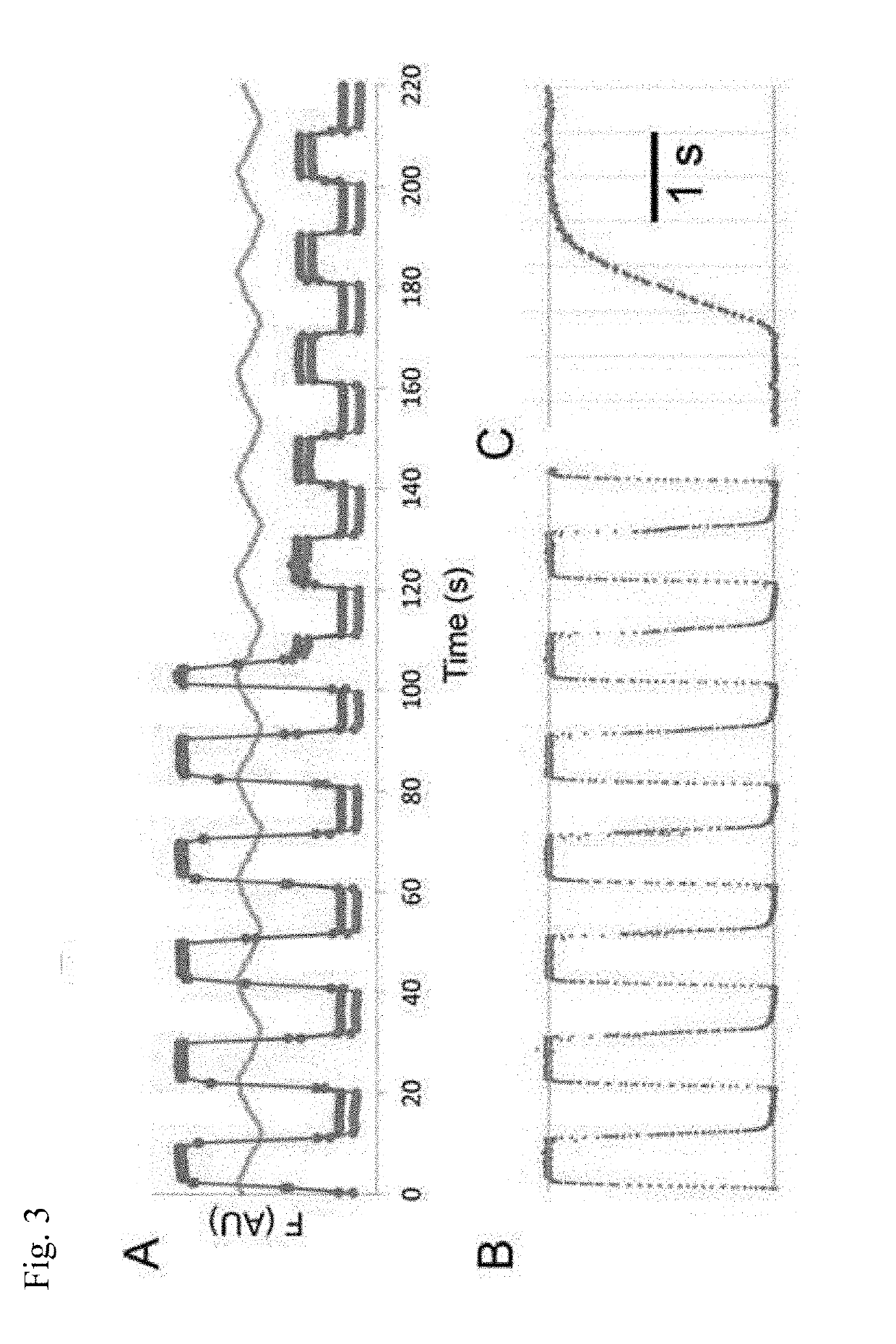Membrane transporter assay and methods of use
a membrane transporter and assay technology, applied in the field of materials and methods for membrane transporter assay, can solve the problems of difficult or even impossible purification and characterization of active transporters, limited methods for functional measurement,
- Summary
- Abstract
- Description
- Claims
- Application Information
AI Technical Summary
Benefits of technology
Problems solved by technology
Method used
Image
Examples
example 1
SLC26a3-Mediated Transport of Cl− / HCO3−
[0097]SLC26a3 (A3), a Cl− / HCO3− exchanger, is expressed in many tissues where it plays various roles in pH regulation and chloride balance (Ohana et al., 2009 J. Physiol. 587:2179-2185). A3 exchange of Cl− / HCO3− was characterized with the OSTA method (FIG. 4). Cells expressing A3 were loaded with the pH-sensitive dye SNARF-5F-AM, and perfused with buffers oscillating every 5 s (total period 10 s) between 8 and 158 mM Cl−, and in the presence of 25 mM HCO3−, and with a confocal microscope frame rate of ˜2 Hz (FIG. 4A). A uniform oscillating response in the SNARF-5F signal was observed to follow the stimulus (FIG. 4B-D). Since the drug salicylate is known to inhibit a nontransporting paralog to A3, prestin (SLC26a5) (Santos-Sacchi et al., 2006 J. Neurosci. 26:3992-3998; Zheng et al., 2000 Nature 405:149-155), 10 mM salicylate was added to the oscillating buffers to determine its effect on A3. At this concentration, salicylate was found to abrogat...
example 2
SLC26a2-Mediated Exchange of SO42− / OH−
[0098]Another transporter from the SLC26 family, SLC26a2 (A2), has been implicated in a number of osteochondrodysplasias (bone growth abnormalities) due to mutations affecting its normal SO42− / OH− exchange activity (Dawson and Markovich, 2005 Curr. Med. Chem. 12:385-396), which is critical for sulfation of cartilage and extracellular matrix. Normal transport has been reported to require extracellular Cl− to allosterically gate the normal SO42− / OH− exchange function (Ohana et al., 2012 J. Biol. Chem. 287:5122-5132). Thus, an experiment was devised in which permutations of SO42−, Cl−, and OH− could be perfused onto SNARF-5F-loaded cells expressing A2 (FIG. 5A). The primary stimulus was oscillation of SO42− from 0 to 100 mM with a period of 40 seconds, and this was continued throughout the entire experiment. In the first phase of the experiment (FIG. 5B-D), the buffers were held at pH 7.5 and 0 Cl−. As expected, this resulted in negligible oscillat...
example 4
EAAT2-Mediated Transport of Glutamate
[0101]Due to its prominence and its intricate stoichiometry (3 Na+, 1 H+, and 1 glutamate for 1 K+ (Levy et al., 1998 J. Neurosci. 18:9620-9628)), EAAT2 seemed another appropriate candidate through which to explore further the universality of the method. Excitatory amino acid transporters (EAAT's) were first described in 1978 (Kanner and Sharon, 1978 Biochemistry 17:3949-3953), and have since become well known for their critical role at glutamatergic synapses in the central nervous system (CNS), where they re-uptake the neurotransmitter glutamate and thereby terminate signaling and prevent excitotoxicity (Jensen et al., 2015 Curr. Opin. Pharm. 20:116-123; Nakagawa and Kaneko, 2013 Curr. Mol. Pharmacol. 6:66-73). EAAT2, also known as GLT-1 or SLC1A2, is primarily expressed in astrocytes, and is responsible for the majority of glutamate reuptake in the CNS (Tanaka et al., 1997 Science 276:1699-1702). Defects in EAAT2 are implicated in cerebral stro...
PUM
 Login to View More
Login to View More Abstract
Description
Claims
Application Information
 Login to View More
Login to View More - R&D
- Intellectual Property
- Life Sciences
- Materials
- Tech Scout
- Unparalleled Data Quality
- Higher Quality Content
- 60% Fewer Hallucinations
Browse by: Latest US Patents, China's latest patents, Technical Efficacy Thesaurus, Application Domain, Technology Topic, Popular Technical Reports.
© 2025 PatSnap. All rights reserved.Legal|Privacy policy|Modern Slavery Act Transparency Statement|Sitemap|About US| Contact US: help@patsnap.com



